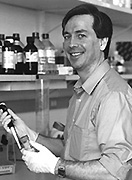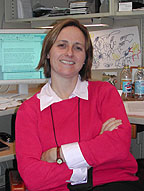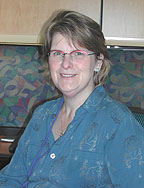
| T H E N I H C A T A L Y S T | N O V E M B E R – D E C E M B E R 2003 |
|
|
|
| P E O P L E |
RECENTLY TENURED
 |
|
Peter
Aplan
|
Peter Aplan received his M.D. degree from Pennsylvania State University at University Park in 1983. He was a pediatric intern, resident, and chief resident at the Children’s Hospital of Buffalo, New York, from 1983 to 1987. He was a pediatric hematology-oncology fellow and then a biotechnology fellow at NIH from 1987-1992. He moved to Roswell Park Cancer Institute in Buffalo, where he was an assistant professor and then associate professor of pediatrics and microbiology before joining the Genetics Branch at NCI in 1999. He is now a senior investigator and head of the Leukemia Biology section in that branch.
My laboratory studies nonrandom chromosomal translocations associated with hematologic malignancy. Translocations have proven to be a rich source of insights into cancer biology as well as many fundamental biologic processes. For instance, the antiapoptotic bcl2 gene was initially identified due to its involvement in a recurrent chromosomal translocation.
Our studies begin with a clinical observation, namely, a chromosomal abnormality associated with hematologic malignancy. Our general approach is to clone the translocation and identify the gene(s) involved, determine a mechanism by which the translocation might have occurred, and develop animal models of leukemia using the genes identified. Our ultimate goal is to identify causes of these oncogenic translocations (so that they might be avoided), and to identify pathways activated by these translocations, so that these pathways might be targeted for therapeutic intervention.
As a postdoctoral fellow, I identified and characterized several chromosomal rearrangements involving the SCL gene, which is activated by chromosomal rearrangements in approximately 30 percent of patients with T-cell acute lymphoblastic leukemia. Our laboratory has developed a mouse model for this type of leukemia using SCL transgenic mice. Almost 100 percent of the mice develop a fatal leukemia that resembles the human disease in clinical presentation, pattern of spread, invasion, morphology, and immunophenotype. To mimic the human disease more closely, we have used Cre-lox technology to generate inducible rearrangement and expression of the SCL transgene.
More recently, we have begun experiments aimed at modeling leukemia in zebrafish. Zebrafish offer several advantages to the cancer biologist: Adult fish are approximately one inch long, and many fish can be housed in a small space. They have large, easily manipulated eggs. These can be microinjected to generate transgenic fish. Because the fish are transparent for the first weeks of life, we can track development using fluorescent proteins.
Over the past several years, my lab has cloned and characterized several chromosomal translocations that are seen in patients with acute myelogenous leukemia and produce NUP98 fusion genes. NUP98 is normally a component of the nuclear pore complex, which mediates transport of RNA out of, and protein into, the nucleus. We have developed lines of transgenic mice that overexpress an NUP98-HOXD13 fusion gene. These mice develop pancytopenia and a myelodysplastic syndrome that progresses to acute myeloid leukemia.
The experiments I described above focused on demonstrating that genes activated by chromosomal translocations lead to leukemia. This is just the beginning for us. If the chromosomal translocation does cause leukemia, it becomes important to determine what caused the chromosomal translocation. Therefore, in addition to studies aimed at characterizing the downstream effects of leukemic chromosomal translocations, we are also quite interested in learning the mechanisms by which chromosomal translocations (and other gross chromosomal rearrangements) occur.
We showed that we can reproducibly cleave genomic DNA at or near sites of known translocation breakpoints within the MLL (mixed lineage leukemia) gene using known genotoxic agents. Improper repair of these breaks could result in chromosomal translocation. We are now developing a system in which we can use the rare-cutting restriction enzyme I-SceI to induce a single double-strand break in cells and determine whether improper repair of this break leads to chromosomal translocation.
 |
|
Crystal
Mackall
|
Crystal Mackall received her M.D .from Northeastern Ohio Universities of Medicine, Rootstown, Ohio, in 1984 and completed a combined internal medicine/pediatrics residency in Akron, Ohio, in 1988. In 1989, she joined NCI in the Pediatric Oncology Branch as a clinical associate. She was a postdoc in the Transplantation Biology Section of the Experimental Immunology Branch, NCI, from 1990 to 1996 and is currently a senior investigator in the Pediatric Oncology Branch, NCI.
Dramatic advances in the basic understanding of cellular immunity over the past several decades have opened up the real possibility that clinically relevant immune-based therapies for many human cancers will soon emerge. Translating these basic insights into clinical gains requires a fundamental understanding of both sides of the host-tumor interface. The major long-term goal of my lab is the development of immune-based therapies for pediatric cancers. My research focuses heavily on the study of the immune system in cancer patients, especially those who have undergone standard cancer therapies.
After completing clinical training in the Pediatric Oncology Branch, I undertook postdoctoral work in transplantation biology in Ron Gress’ lab. There, I focused on basic questions related to the regeneration of T-cell populations after T-cell depletion due to therapy and/or disease. Using mouse models, I identified markers to distinguish T cells regenerated via thymic-dependent vs. thymic-independent pathways and identified differences in levels of immune competence depending upon which pathway was utilized.
Translating these findings to the clinic, we then undertook studies of T-cell regeneration in children and young adults treated with intensive chemotherapy for cancer. I identified reduced thymic function as the primary cause of slow immune recovery in these patients. Diminished thymic function as a primary cause of slow immune recovery was subsequently confirmed in other states of T- cell deficiency, including those attributable to HIV infection and bone marrow transplantation.
I then began to focus on identifying factors that regulate T-cell regeneration that could potentially be used to enhance immune reconstitution. We identified IL-7 as a potent therapeutic capable of enhancing T-cell regeneration in mouse models.
More recently, my laboratory demonstrated that endogenous IL-7 levels rise in response to CD4 depletion in a variety of clinical settings. These observations, as well as the demonstration by other groups that IL-7 is required for thymic-independent homeostatic expansion, led to the paradigm that IL-7 is a "master regulator of T-cell homeostasis." On this basis, we have worked to develop early clinical trials of recombinant human IL-7. The first such trial recently opened in the Clinical Center.
In addition to T-cell regeneration, the immunobiology of pediatric cancer is another area my lab pursues. We have focused primarily on Ewing’s sarcoma, an aggressive, poorly differentiated bone and soft tissue tumor that afflicts children and young adults. We have identified Ewing’s sarcoma as highly responsive to both Fas-based and TRAIL-based apoptosis. Recently, we published the first evidence that endogenous immune responses exist in patients with Ewing’s sarcoma. Work is underway to find the best way to immunize patients against Ewing’s sarcoma and/or adoptively transfer T cells reactive to it.
My long-term goal is to use the discoveries we have made in immune reconstitution to develop immune-based therapies for patients with minimal residual disease. This is particularly pertinent to pediatric tumors, where intensive multimodality therapy is the rule in treatment regimens. As a means toward this end, we are currently conducting clinical trials of tumor vaccines, allogeneic bone marrow transplants, and adoptive transfer of autologous lymphocytes, after chemotherapy for pediatric sarcomas.
Ultimately through this work, I hope to develop clinical trials that integrate immune restoration with state-of-the-art adoptive therapy and/or tumor vaccines to direct the regenerating immune system to react against tumor antigens. I believe that through this approach, immune therapy will be effectively integrated into the oncologic armamentarium and yield the greatest benefit.
 |
|
Colleen
McBride
|
Colleen McBride received her Ph.D. from the University of Minnesota, Minneapolis, in 1990 and did her postdoctoral training at Group Health Cooperative of Puget Sound in Seattle. She came to NIH in October of this year as a tenured senior investigator to lead NHGRI’s newly formed Social and Behavioral Research Branch.
Before coming to NHGRI, I spent 15 years developing innovative public- health interventions to promote behavior change to reduce health risks. In a series of randomized controlled trials, I developed and evaluated a broad range of behavior change interventions including:
![]() smoking prevention and cessation
smoking prevention and cessation
![]() treatment decision-making
treatment decision-making
![]() dietary change
dietary change
![]() physical activity
physical activity
![]() sexually transmitted disease prevention
sexually transmitted disease prevention
The common aim of these trials was to design and evaluate low-cost, self-directed behavior change interventions for large and geographically dispersed populations at risk for chronic diseases and cancer. In particular, my research maximized the potency of brief interventions by taking advantage of "teachable moments"—health-related events that naturally increase motivation for making lifestyle changes.
My early research in smoking and pregnancy suggested that feedback of test results could yield teachable moments. For example, learning they are pregnant prompts up to half of women to stop smoking spontaneously. Unfortunately, without formal behavioral interventions, most women return to smoking after giving birth.
I also tested annual Pap screening and receiving test results showing low-grade cervical abnormalities as a possible teachable moment for quitting smoking. Generally, women were unaware of the link between cigarette smoking and cervical cancer and did not understand the
mechanisms through which their risk might be increased.
My colleagues and I developed and evaluated a quit-smoking intervention for women receiving Pap smear results. Unfortunately, this intervention resulted in no greater smoking quit rates among women with an abnormal Pap test than among women with normal results. These results piqued my interest in exploring how to communicate "normal" and "abnormal" results or to explain biological mechanisms in ways that could be understood by lay audiences and would motivate behavior change.
This led to the idea of using feedback from genetic susceptibility testing as a motivator for behavior change. With funding from NCI, my colleagues and I evaluated feedback on genetic susceptibility to lung cancer to motivate smoking cessation among African Americans. For this campaign, we developed a car-wash metaphor and graphical images to communicate what the genetic marker glutathione S transferase enzyme could and could not tell a smoker.
The study showed that smokers could understand genetic results they got in the mail—with follow-up counseling on the telephone—just as well as results and counseling received in person. But we also found that learning that one was genetically susceptible to lung cancer was not associated with higher rates of smoking cessation. The data indicated only about half of the smokers fully understood the meaning of the test result. Results also showed that smokers may have been biased in remembering the result: Those with results indicating the greatest health risk, who got the most threatening message, were most likely to recall their results incorrectly.
Looking ahead, in my next
five years at the NHGRI Social and Behavioral Research Branch, my goal is to
work with colleagues to build a leading-edge, collaborative research program
using diverse scientific perspectives and genomic discoveries to develop public-health
interventions with the promise of real-world dissemination. I also want to continue
to explore psychological processes that might help explain misunderstanding
of biomarker feedback. Another goal is to develop tools to assess key elements
of teachable moments so that we might capitalize on these events to increase
the efficacy of health promotion efforts. ![]()